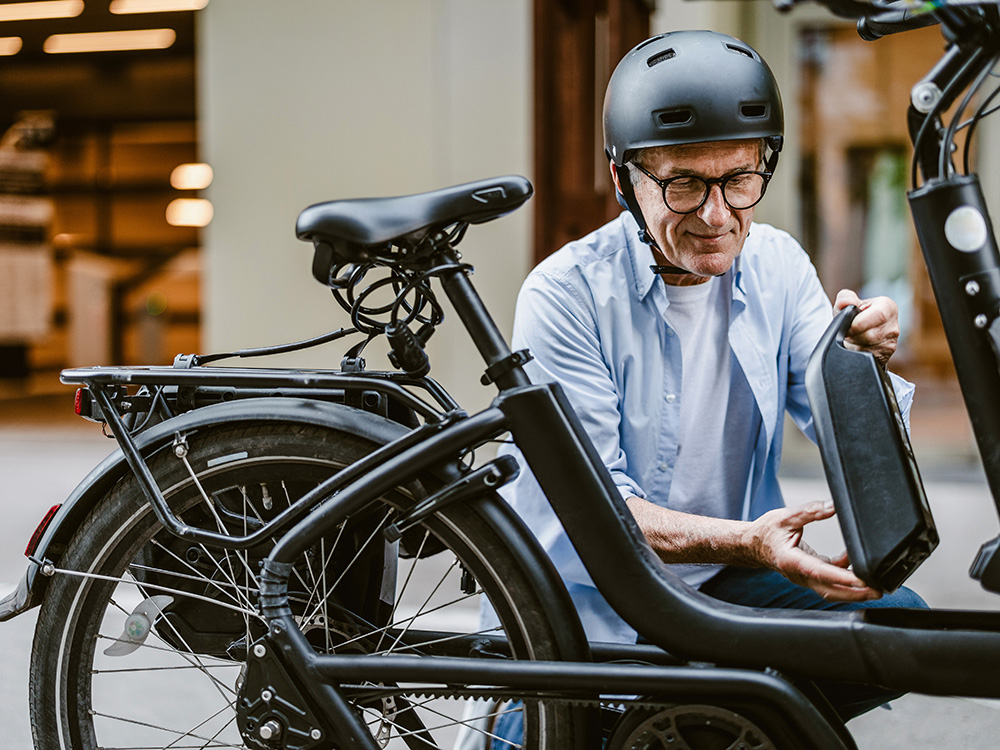E-bikes instead of cars.
Text: Barbara Spycher
Faster than a bicycle, more environmentally friendly than a car: e-bikes offer numerous advantages. What exactly persuades people to switch from four wheels to two?
Nowadays, e-bikes can be seen whizzing across rural and urban areas at up to 45 kilometers an hour — and in increasing numbers. This surge in usage also offers considerable potential in terms of transport and climate policy. E-bikes could help to reduce CO2 emissions in transport because they make cycling an attractive option for more people and, thanks to their higher speeds, they can serve as a substitute for cars even over long distances. How does that work in reality? In what circumstances? And how much CO2 can actually be saved?
As part of the e-Biking in Switzerland (EBIS) study, a team from the University of Basel and ETH Zurich has spent three years addressing these questions. Under the leadership of Beat Hintermann, Professor of Public Economics at the University of Basel, the researchers priced in the external costs of transport. Specifically, they conducted a field experiment in which they took the consequential costs due to noise, accidents and emissions that are normally borne by the general public and charged them directly to study participants. This made driving a car significantly more expensive and public transport slightly more expensive, whereas there was no additional cost for using an e-bike.
The result of this “mobility pricing” system was that people reduced their car journeys — by 8.2% — and instead covered greater distances by e-bike and on foot. “For the first time in Switzerland, there is clear evidence that people will replace car kilometers with bike kilometers if the external costs are factored in,” says Hintermann. Thanks to these altered habits, e-bikers save 25% of their traffic-related CO2 emissions. “That’s a considerable amount per person,” says the economist. If this is scaled up to the population as a whole, however, the saving is just 0.25% — because there are still relatively few people who travel by e-bike.
For their experiment, Hintermann and colleagues chose an empirical approach based on GPS tracking via a mobile phone app. The 1,085 study participants were all e-bike riders who also regularly drove. The GPS recorded how many kilometers they traveled each day by car, by e-bike, by public transport and on foot. Following a control phase, the e-bike users received a mobility budget, from which the external costs caused by their transport behavior were deducted on a weekly basis.
Car-kilometers were the most expensive because they have the greatest consequential costs in the form of accidents, noise emissions and air pollution. Time spent in a traffic jam was also given a price tag. On the other hand, credit was even awarded for kilometers traveled on foot. This is because the calculations also took account of the benefits of walking, which reduces healthcare costs for society as a whole.
Underlying data for true-cost pricing.
“From an economic perspective, it’s essential to factor in the external costs,” says Hintermann. Only then would most people take account of the costs to the general public when making decisions. With their randomized controlled trial, Hintermann and colleagues were able to show not only that mobility pricing means people travel less often by car and more often by e-bike, but also that the external costs decrease overall. Indeed, the cost to society for healthcare or emissions-related impacts was 6.5% lower.
Hintermann is in no doubt that a pricing system of this kind would be beneficial for society — but how could it be put into practice outside the context of the GPS-tracking experiment? Apparently, there are various ways of adjusting the relative prices of car journeys, public transport and cycling and therefore of achieving true-cost pricing. “The simplest thing would probably be a higher fuel tax.” This would take account of the greater social cost of driving. If we were also to introduce perimeter pricing (a tax applied to car journeys in downtown areas), he says, we would achieve some 60% of the societal gain seen in the experiment.
In the past, however, such interventions have generally faced a hard time politically. In Hintermann’s view, the key thing would be to redistribute the revenue gained from mobility pricing to the general public — and on a per capita basis. This would prevent the burden from falling disproportionately on poorer households.
The EBIS study stands out not only for the pricing experiment and CO2 calculations, but also for its extensive dataset relating to e-bike users. For the first time, GPS tracking allows transport planners to monitor where cyclists actually travel: They avoid steep climbs and routes with lots of motorized traffic or traffic lights, instead favoring shorter routes and separate cycle lanes. Moreover, there are still some people — particularly women — who don’t ride a bike or only do so rarely because of fears relating to safety.
“Cycling becomes much more attractive if you invest in separate cycle lanes and streets with low speeds and little interaction with other road users,” says Hintermann, citing the study. In conclusion, he adds: “Government and politicians have various tools — and now also data — in their hands in order to better harness the potential of e-bikes from a transport and climate policy perspective.”
More articles in this issue of UNI NOVA (May 2025).

